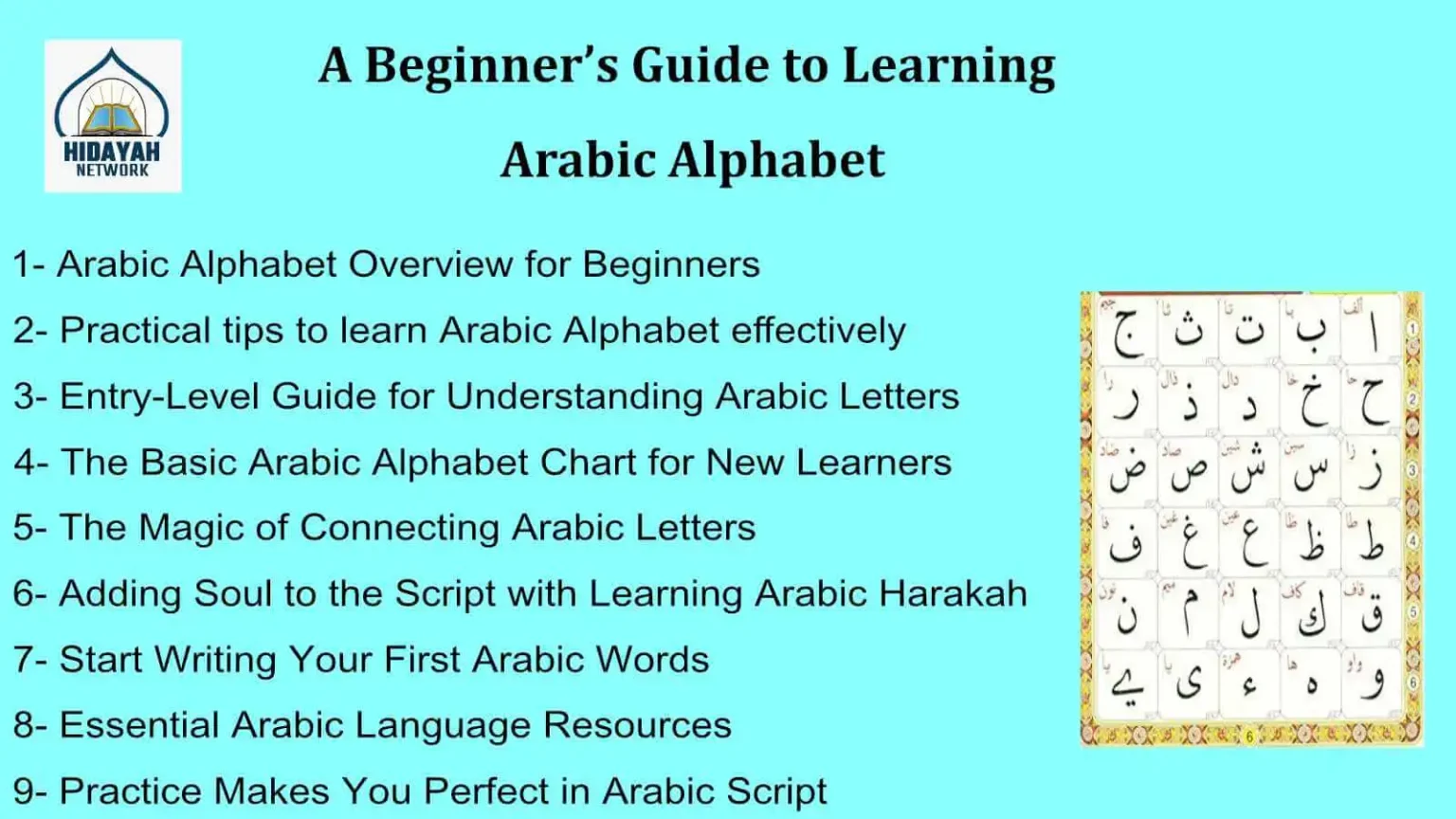Learning the Arabic Alphabet is one of the most primary steps to take as a beginner. The Arabic alphabet holds great importance on how you progress to the next stage of the language learning process. Thankfully, there are amazing effective ways that you can implement into your daily Arabic learning plan to learn the alphabet as efficiently as possible.
Begin with a detailed overview of the Arabic alphabet, make a basic alphabet chart and use that for learning, learn the magic of connecting Arabic letters, understand Harakah, construct simple Arabic words using Arabic letters, use associations to remember the shape and sound of each letter, and more. With similar exciting and practical tips, we assure you that you will have mastered the art of learning Arabic alphabet soon. Let’s get stuck into more detail below!
Table of Contents
Toggle11 Tips for A Beginner’s Guide to Learn Arabic Alphabet
Follow our step-by-step guide to learning Arabic Alphabet for newbies:
1- Arabic Alphabet Overview for Beginners
The Arabic alphabet is composed of 28 letters, and it’s essential for beginners to grasp the basics before delving into the language. Some key points for an Arabic alphabet overview include:
- Number of Letters: Arabic has 28 letters, written from right to left.
- Focus Letters: Prioritize learning foundational letters such as Alif, Ba, Ta, Tha, and Jeem.
- Most Used Letters: Pay extra attention to frequently used letters like Alif, Lam, Meem, and Noon.
- Special Characteristics: Arabic letters can change shape based on their position in a word, exhibiting initial, medial, final, or isolated forms.
- Differences from English: Arabic letters may look different and have unique sounds compared to English. Special emphasis on guttural sounds like ق (Qaf) and ع (‘Ain) is crucial.
Beginners should practice recognizing these letters individually and in various contexts to build a solid foundation for Arabic language learning.
2- The Basic Arabic Alphabet Chart for New Learners
Learning how to read Arabic fluently is an essential step to understanding this beautiful and intricate script. Here’s a handy chart with all 28 Arabic letters, including their names and sounds:
| Initial form | Arabic Alphabet | Isolated form | Medial form | Final form | Transliterated |
| ا | أَلِف | أ | ـا | ـا | ālif |
| بـ | بَاء | ب | ـبـ | ـب | bā̛ |
| تـ | تَاء | ت | ـتـ | ـت ـة | tā̛ |
| ثـ | ثَاء | ث | ـثـ | ـث | thā̛ |
| جـ | جِيم | ج | ـجـ | ـج | jim |
| حـ | حَاء | ح | ـحـ | ـح | hā̛ |
| خـ | خَاء | خ | ـخـ | ـخ | khā̛ |
| د | دَال | د | ـد | ـد | dāl |
| ذ | ذَال | ذ | ـذ | ـذ | zāl |
| ر | رَاء | ر | ـر | ـر | rā̛ |
| ز | زَاي | ز | ـز | ـز | zāy |
| سـ | سِين | س | ـسـ | ـس | sin |
| شـ | شِين | ش | ـشـ | ـش | shin |
| صـ | صَاد | ص | ـصـ | ـص | sād |
| ضـ | ضَاد | ض | ـضـ | ـض | dād |
| طـ | طَاء | ط | ـطـ | ـط | tā̛ |
| ظـ | ظَاء | ظ | ـظـ | ـظ | ẓā̛ |
| عـ | عَينٍ | ع | ـعـ | ـع | ʿain |
| غـ | غَين | غ | ـغـ | ـغ | ghain |
| فـ | فَاء | ف | ـفـ | ـف | fā̛ |
| قـ | قَاف | ق | ـقـ | ـق | qāf |
| كـ | كَاف | ك | ـكـ | ـك | kāf |
| لـ | لاَم | ل | ـلـ | ـل | lām |
| مـ | مِيم | م | ـمـ | ـم | mim |
| نـ | نُون | ن | ـنـ | ـن | nun |
| هـ | هَاء | ه هـ | ـهـ | ـه | hā̛ |
| ـو | وَاو | و | – | ـو | wāw |
| يـ | يَاء | ي | ـيـ | ـي | yā̛ |
| أ ؤ | هَمزَة | ء أُإِ أَ | ـئـ | ئ | hamza |
Get 40% OFF Now!
3- Adopt Practical Tips to Learn Arabic Alphabet Effectively

Understanding the Arabic alphabet is enjoyable, but practice is necessary to master it. Practical ideas and tips to memorise Arabic Alphabet that eases your journey to learn Arabic in 3 months:
- Consistency is key to learning Arabic script, as with any new ability. Daily Arabic alphabet practice. Making continuous progress is vital, whether it takes minutes or hours.
- Learn the Arabic alphabet regularly. Regularity will promote learning and maintain consistent progress.
- Flashcards and mnemonics help memorization. Make letter flashcards and practice daily. Moreover, mnemonics can also help you remember each letter by associating it with something memorable.
- Join language groups or classes like Hidayah Network for support and practice. However, language enthusiasts can advise and support you.
4- Entry-Level Guide for Understanding Arabic Letters
The vowels, consonants, and different letter forms in Arabic script are what make the Arabic letters different from those in other languages. Let’s delve into these fascinating elements:
Consonants and Vowels
Arabic, renowned for its complexity, relies on a diverse range of consonant sounds, including unique ones like “ق” (qaf), “خ” (kha), and “غ” (ghayn). Pronunciation of consonants varies based on their position within words, showcasing the script’s adaptability.
Vowels play a significant role, with short vowels (“Fatha,” “Damma,” and “Kasra”) denoting “a,” “u,” and “i” sound, respectively. Long vowels (“ا,” “و,” and “ي”) are critical for word formation and meaning differentiation.
Letter Forms
In Arabic, there are four forms of letters. These letters transform their shape based on their position in a word, featuring four primary forms:
The Isolated Form, the Initial Form, the Medial Form, and the Final Form.
Alphabet Pronunciation Guide
These 28 alphabets have unique Arabic sounds.
- Phonetic Clarity: Arabic letters have distinct sounds, such as “خ” (kha) and “ق” (qaf). Pay attention to these unique sounds.
- Short Vowels: Use diacritical marks (harakat) like “ـَ” (Fatha) for “a,” “ـُ” (Damma) for “u,” and “ـِ” (Kasra) for “i” to ensure accurate pronunciation.
- Long Vowels: Long vowels like “ا” (alif), “و” (waw), and “ي” (ya) contribute to word nuances. Master their pronunciation for clarity in the Arabic Alphabet and advance language.
Note: Learn Makharij of Arabic Letters to help you improve your pronunciation and enhance your language-learning experience.
5- The Magic of Connecting Arabic Letters
The beauty of Arabic script lies in how its letters connect to form words. Discover the art of joining letters and explore the world of ligatures and special letter combinations.
Joining Letters
In Arabic, letters flow seamlessly from one to the next. In fact, this fluidity enhances the visual appeal of the script and contributes to the language’s unique charm.
Ligatures and Special Letter Combinations
Arabic features ligatures and special letter combinations that lend a distinctive character to the script. These combinations add elegance and intricacy to written Arabic.
6- Adding Soul to the Script with Learning Arabic Harakah
Harakah, or Arabic vowels, brings life into the script. Understand the roles of Fatha, Damma, and Kasra, and explore the nuances of Sukun and Shadda. Learn the art of pronouncing vowels in Arabic words.
Fatha, Damma, and Kasra are diacritical marks representing short vowels in Arabic. Furthermore, these provide clarity and pronunciation guidance. Fatha is “a,” Damma is “u,” and Kasra is “i.”
Sukun indicates a consonant should be pronounced without a vowel. while Shadda doubles a consonant’s sound. Furthermore, these marks influence word pronunciation and meaning.
Mastering the pronunciation of Arabic vowels is vital for understanding and speaking the language fluently. Learn how these vowels come to life within words, adding depth and soul to the script.
7. Group Similar-Looking Arabic Letters to Ease Learning
When you’re learning the Arabic alphabet, it can be helpful to group together letters that look similar. This makes it easier to remember them and reduces confusion. Let’s look at a couple of pairs of similar-looking Arabic letters and how to group them effectively:
1. ـب (Ba) and ت (Ta)
Both letters have a similar shape, but one has two dots (ـب) while the other has one dot (ت).
2. ـن (Nun) and ـم (Meem)
These letters share a similar shape with one main loop, but Nun has two dots while Meem has no dots.
3. ـس (Seen) and ش (Sheen)
Both letters have a similar base, but Sheen has three small dots on top.
Grouping Practice
- Pay attention to the overall shape of the letters.
- Note the number of dots or any additional marks that differentiate them.
- Form cute or memorable associations to distinguish between them.
8. Construct Simple Arabic Words Using the Arabic Alphabet
Constructing simple Arabic words using the Arabic alphabet is a fantastic way to apply what you’ve learned. Let’s dive into creating words using a couple of examples:
Word: كِتَاب (Kitab) – Book
Breakdown:
ك (Kaf) + ت (Ta) + ا (Alif) + ب (Ba)
Word: مَدْرَسَة (Madrasa) – School
Breakdown:
م (Meem) + د (Dal) + ر (Ra) + ا (Alif) + س (Seen) + ة (Taa Marbuta)
Word: بَيْت (Bayt) – House
Breakdown:
ب (Ba) + ي (Ya) + ت (Ta)
Constructing Practice
- Begin with words that have fewer letters to build confidence.
- Practice pronouncing each letter in the word.
- Pay attention to the flow of the letters when connecting them to form a word.
- Try creating words related to your daily life or things around you.
9. Use Associations to Remember the Shape and Sound of Each Arabic Letter
Associating Arabic letters with shapes and sounds is a clever way to remember them easily. Let’s explore how to create associations with a few examples:
- ج (Jeem)
- ض (Dhad)
- خ (Khaw)
Creating Associations Practice
- Look closely at the shape of the letter and find something familiar in it.
- Pay attention to the sound the letter makes and associate it with a familiar word or object.
- Create a mental image or story that links the shape and sound of the letter.
Pro Tip: Reinforce associations by incorporating them into your daily routine. Say the associations out loud or draw them to reinforce your memory.
10. Start Writing Your First Arabic Word
Now that you understand the basics, it’s time to write your first words:
Simple Arabic Vocabulary
Start with everyday Arabic words that will help you communicate better and build your knowledge. To get used to the script, write these words over and over again.
Writing Practice
Set aside time every day to work on your writing. Writing will help you improve at making Arabic letters and words the more you do it. The path to success is a rewarding one.
11. Essential Arabic Language Resources
In order to help you learn Arabic, here are some useful tools that can speed up your progress:
- Arabic Alphabet Worksheets: These worksheets give you organized activities to help you learn and practice writing in Arabic.
- Online Lessons and Apps: To Learn Arabic online for beginners is a convenient and accessible way to embark on your language journey. There are a lot of online lessons and apps that can help you learn Arabic.
- Language Learning Books: Buy well-organized language learning books with tasks and explanations on Arabic writing and pronunciation.
With these helpful tools, you will learn the Arabic alphabet and language faster and better. Establish a reading schedule that suits your daily routine. You’ll find the help you need to achieve whether you like traditional worksheets, interactive online tools, or complete language learning books.
Enroll in Arabic Classes at Hidayah Network to Learn Arabic Alphabet
Learning Arabic for beginners is now easy with a well-structured course. Discover the world of Arabic with our classes designed for all levels. From Arabic classes for kids to non-natives, Hidayah Network offers comprehensive courses tailored to your needs.
Conclusion
In conclusion, our beginner’s Guide to Learning Arabic Alphabet provides worksheets, online tutorials, and language study materials to help you learn Arabic. Arabic lessons for kids are also available. This guide makes learning Arabic, especially for novices, an exciting journey into a rich and intriguing language. Moreover, consistent writing practice makes learning Arabic fun. May your journey be filled with enlightenment and spiritual growth.
Most Important FAQs
Arabic letters have different forms based on their position in a word. The four primary forms are: Isolated Form, Initial Form, Medial Form, and Final Form. also, this adaptability allows Arabic script to create cursive, flowing words.
The Arabic alphabet comprises four primary forms: Isolated Form, Initial Form, Medial Form, and Final Form.
Yes, the Arabic alphabet remains consistent across different regions and Arabic-speaking countries.
They are ا (alif), د (daal), ذ (dhaal), ر (raa), ز (zayn / zaa), and و (waaw) that are not connect with other letters.

About Author

